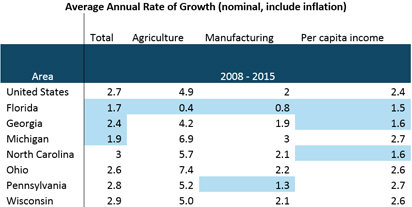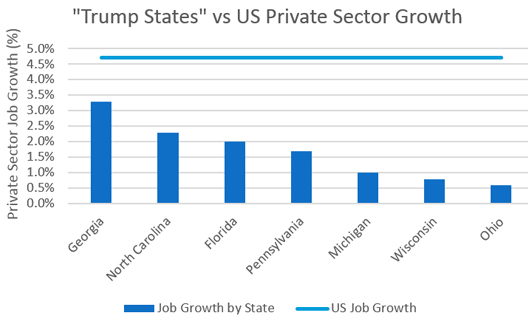 Donald Trump’s victory in the US presidential election on November 8 came as a major surprise— especially to pollsters and political pundits. But it should have come as no surprise to those who were paying close attention to the economic indicators in the swing states, states that can tip the outcome of a US presidential election because they have a significant number of votes in the Electoral College and neither major political party is guaranteed to win the votes of the state, that decided the election.
Donald Trump’s victory in the US presidential election on November 8 came as a major surprise— especially to pollsters and political pundits. But it should have come as no surprise to those who were paying close attention to the economic indicators in the swing states, states that can tip the outcome of a US presidential election because they have a significant number of votes in the Electoral College and neither major political party is guaranteed to win the votes of the state, that decided the election.
Based on polls and historical evidence, a Trump victory was not expected in the states that swung the election in the Republican’s favor: Florida, Georgia, Michigan, North Carolina, Ohio, Pennsylvania, and Wisconsin.
Pennsylvania and Michigan have not voted for a Republican presidential candidate since 1988, and neither Florida nor Ohio have voted for a Republican candidate since 2004. On the other hand, although North Carolina and Georgia have historically voted for the Republican presidential candidate, polls did not show a definitive winner in either state prior to election day.
Analysis, however, shows that economic performance in most swing states has fallen far below the US average on US President Barack Obama’s watch. This reality contributed to a majority of residents of these states voting for Trump, the candidate who promised economic growth for those “left behind.” While the United States as a whole did fairly well in rebounding from the great recession of 2008, improvements were less evident in states such as Florida, Michigan, Georgia, or North Carolina (Table 1). Table 1. Source: Bureau of Economic Analysis
Table 1. Source: Bureau of Economic Analysis
*Light blue figures are the most significant differences from the US average.
The average annual rate of growth for the US economy from 2008 to 2015 has been 2.7 percent in nominal terms. In contrast, Florida saw only 1.7 percent growth, Michigan fared slightly better at 1.9 percent, and Georgia saw growth of 2.4 percent. In Florida, in particular, growth in the agriculture sector remained, on average, flat, and the level of sectoral output today is nearly the same as it was in 2007. In these states, where total economy average annual growth was increasing at a lower rate than the total economy of the United States, it should have been clear that voters would have supported a candidate who blamed the state of the economy on the current president, spread the message that his opponent would have continued the current economic trend, and promised to reinvigorate the economy in a way that would have improved the quality of life for these voters. What is interesting is that Trump’s Democratic opponent, Hillary Rodham Clinton, was projected to win Michigan, and polls did not indicate a decisive winner in Florida or Georgia.
In addition to the slow economic growth, income per capita also fell in some of the swing states relative to the national average. The US average annual rate of growth of per capita income has been 2.4 percent between 2008 and 2015. Meanwhile, Florida is trailing at 1.5 percent, and Georgia and North Carolina have experienced 1.6 percent growth rate of per capita income. The sense of lagging behind the rest of the US population might have influenced the majority of voters in these states to vote for Trump.
Of particular interest is that with regard to all economic factors analyzed, as they relate to the outcome of the election—total economy, agriculture, manufacturing, per capita income average annual rate of growth, and all industry private sector employees—Florida has improved at a dramatically lower rate, compared to the other swing states analyzed since 2008.
Another interesting state to consider is Ohio. At the most recent count, Trump won this state by approximately 400,000 votes. However, Ohio’s economic growth is not significantly behind that of the national average. That said, Ohio’s private sector employment has grown the least throughout the Obama years of all the states analyzed. Total private employment growth in Ohio is only 0.6 percent, while the total growth of private jobs throughout the United States has been 4.7 percent. Graph 1 shows the job growth in each of the states analyzed between 2007 and 2015 as measured by the percent change in the number of employees in the private sector per state.
Graph 1. Source: Bureau of Labor Statistics
Trump defined his campaign around the concept of the many “forgotten people” in the United States who were not experiencing the same economic growth as the rest of the country. Looking at the data, it is evident that these “forgotten people” live in the swing states.
Andrea Montanino is the director of the Atlantic Council’s Global Business and Economics Program. You can follow him on Twitter @MontaninoUSA.
Jacqueline Lavalleye is an intern with the Global Business and Economics Program. You can follow the program on Twitter @AC_GBE.
Image: Supporters celebrate as returns come in for Republican US presidential nominee Donald Trump during an election night rally in Manhattan, New York, United States, November 9, 2016. (Reuters/Mike Segar)

